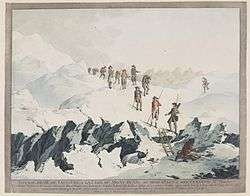Top of the Mont Blanc

Copperplate engraving by Christian von Mechel

The top of the Mont Blanc is a museum piece on display in the Oval Room of Teylers Museum.[1] The specimen was supposedly cut off from the highest findable piece of ice free rock at the top of Mont Blanc on 3 August 1787 during one of the first climbs of the mountain by the Swiss geologist Horace-Bénédict de Saussure.[2]
The climb
The climb was the first known to reach the top of the Mont Blanc, and included around 20 people including De Saussure, his servant and several guides and carriers. The climbing mission was a scientific expedition, during which De Saussure undertook research (among other things) on the boiling point of water at different heights. He calculated the height at each of his experiments by measuring how long it took an alcohol burner to boil an amount of water, and by these means he determined the height of the mountain to be 4775 metres. (This later turned out to be 32 metres less than the actual height of 4807 metres). For these experiments De Saussure brought specific scientific equipment, such as a barometer and thermometer. His calculated boiling temperature of water at the top of the mountain was fairly accurate, only off by 0.1 Kelvin.[2][3]
Acquisition of the exhibition pieces
Teylers Museum was founded just before the climb took place, and at the time serious progress was being made in the research of bedrocks and minerals. The term "geology" was coined by the very initiator of this expedition, De Saussure, and the science was becoming more popular. At that time the museum was still very young and it actively collected knowledge and objects around it and put them on display.
Martinus van Marum acquired the piece from the top of Mont Blanc as well as several other objects from this climb in the fifteen years following it. In 1799, on behalf of the museum, he had already purchased a maquette of Mont Blanc for nine guilders. It had been created in 1787 by the Swiss Charles François Exchaquet and displayed the expedition as well. Although several maquettes were produced at the time, as of 2012 there are only two known to remain - one at Teylers Museum, and one in the Muséum d'histoire naturelle de la Ville de Genève.[4][5] The maquette is believed to be an accurate representation of the mountain and the nearby valley of Chamonix and is 100 by 64 by 35 cm in size, on a 1:15000 scale. Although the dimensions of the maquette are as accurate as possible, the colors are not - they are more informative than accurate. Several drawings and engravings of the view and the expedition were also acquired by Van Marum to complete the set for exhibition. In 1802 he bought the actual "top of the Mont Blanc" together with several other geological samples from Theodore de Saussure (son of the famous geologist), who put together a collection of samples from his father's rocks.[2] The Mont Blanc rock is displayed together with other rocks in the central showcase of the Oval Room. The maquette is also on display in that room.
In popular culture
In 2007 a fictional short film about bringing the top of the mountain back to Mont Blanc, was screened at the Dutch Film Festival.[6]
References and external links
- ↑ The Oval Room is the display location as at 2012
- 1 2 3 Website of the Teylers Museum on the top of the Mont Blanc
- ↑ Article on the climb of the Mont Blanc by Horace-Bénédict de Saussure L. Touret, 'In het spoor van Horace Benedicte de Saussure', in: Teylers Magazijn 4, 1984, p. 1-5 (in Dutch)
- ↑ Terrainmodels: Charles François Exchaquet website
- ↑ article L. Seylaz,'Un émule de H. B. de Saussure: Charles-François Exchaquet, 1746-1792', in: Die Alpen, Les Alpes, Le Alpi, Las Alps 11 (1935), pp. 187-195 (in French)
- ↑ Film het topje van de Mont Blanc